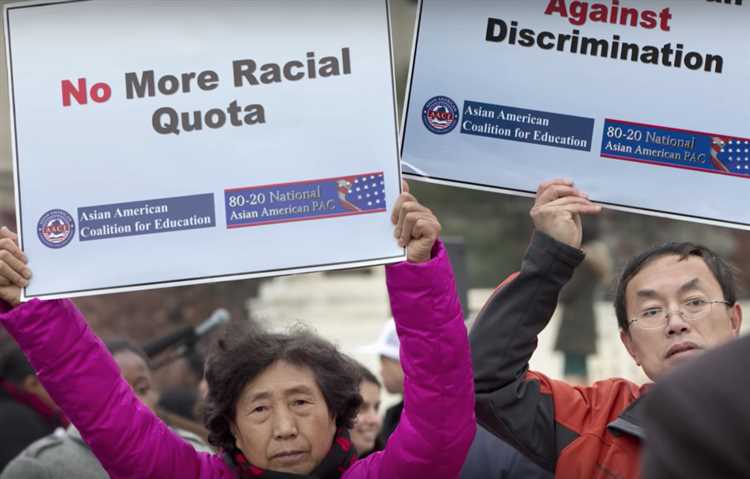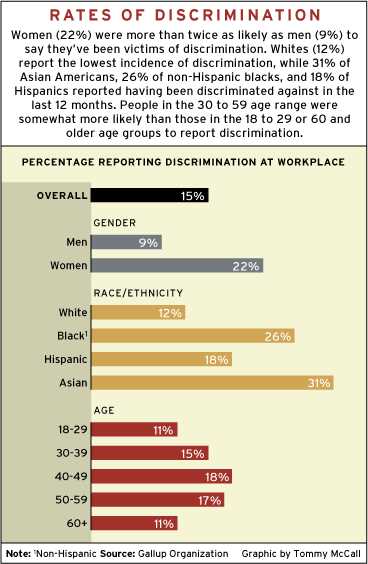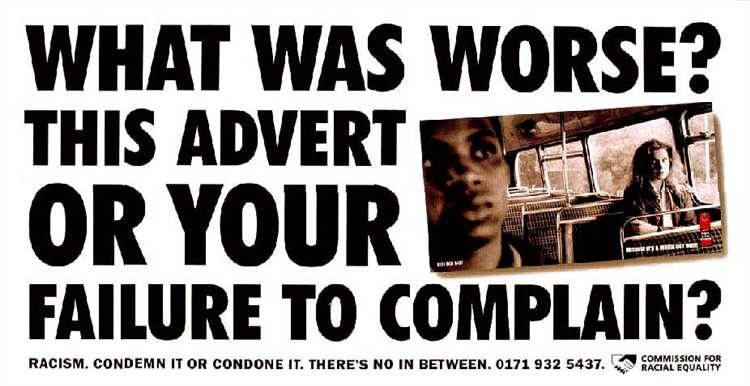Racial quotas have been a contentious topic of discussion in many countries around the world. These policies, also known as affirmative action or positive discrimination, aim to address historical inequalities and promote diversity by allocating a certain percentage of positions or opportunities to individuals from underrepresented racial or ethnic groups.
The purpose of racial quotas is to level the playing field and ensure equal access to opportunities for all individuals, regardless of their racial or ethnic background. Supporters argue that these measures are necessary to address the systemic discrimination and barriers faced by marginalized groups, including but not limited to education, employment, and public services.
However, racial quotas also stir up considerable controversy. Critics argue that these policies can lead to reverse discrimination, as qualified individuals from non-preferential groups may be overlooked in favor of less qualified individuals solely based on their race or ethnicity. These critics argue that merit should be the sole determinant in hiring or admission decisions, rather than factors such as race or ethnicity.
Additionally, racial quotas are often seen as a form of tokenism, where individuals from underrepresented groups may be viewed as mere checkboxes to meet diversity requirements, rather than being valued for their individual talents and abilities. This can create an environment of resentment and perpetuate stereotypes.
Definition of Racial Quotas
Racial quotas refer to policies and practices that allocate a certain percentage or number of positions or opportunities based on a person’s race or ethnicity. These quotas are typically implemented in an effort to address historical disadvantages and promote equal representation for underrepresented racial or ethnic groups. Racial quotas can be applied in various contexts, including education, employment, and political representation.
Quotas are often established as a way to ensure diversity and inclusion by giving specific racial or ethnic groups a fair chance to access opportunities that they may have been historically denied. The underlying principle is that by actively promoting diversity, communities and institutions can benefit from a wider range of perspectives and experiences, resulting in better decision-making and a more equitable society.
However, racial quotas can be a controversial topic, as they involve treating individuals differently based on their race or ethnicity. Critics argue that quotas can lead to reverse discrimination, where individuals from majority groups may face disadvantages in favor of individuals from minority groups. They argue that quotas should not be based on race, but rather on merit and qualifications.
In some countries, the use of racial quotas has been legally challenged. Courts have debated whether the implementation of quotas violates principles of equal treatment and equal opportunity. As a result, some countries have moved away from explicit racial quotas and instead focus on affirmative action policies that aim to address historical disadvantages without explicitly setting quotas.
Overall, racial quotas are a complex and controversial topic. While they aim to promote equality and diversity, their implementation and effectiveness are subjects of ongoing debate and scrutiny.
Purpose of Racial Quotas
Racial quotas are policies implemented by governments or organizations aimed at increasing representation or providing preferential treatment to historically marginalized racial or ethnic groups. The purpose of racial quotas can vary depending on the specific context, but they are generally implemented with the following objectives:
- Promoting Equal Opportunity: Racial quotas are often implemented as a means to address historical inequalities and discrimination faced by certain racial or ethnic groups. By setting specific targets or allocating a certain number of positions specifically for these groups, quotas aim to level the playing field and provide equal opportunities.
- Creating Diversity: Racial quotas are also seen as a way to promote diversity within organizations or institutions. By ensuring representation from a variety of racial or ethnic backgrounds, quotas aim to foster inclusivity and provide different perspectives and experiences, which can lead to enhanced creativity, problem-solving, and overall organizational success.
- Rectifying Past Wrongs: Racial quotas may be implemented as a means of reparations or making amends for historical injustices. Given that certain racial or ethnic groups have faced systemic discrimination and exclusion in the past, quotas can be seen as a way to provide redress and compensate for past wrongs.
However, it is important to note that the purpose and effectiveness of racial quotas are subjects of debate and controversy. Critics argue that quotas can lead to reverse discrimination, undermine meritocracy, and perpetuate stereotypes. Supporters, on the other hand, argue that quotas are necessary to address existing inequalities and create a more inclusive society.
Controversies Surrounding Racial Quotas
Racial quotas have long been a topic of debate and controversy. Advocates argue that they are necessary to address historical disadvantages and promote diversity, while opponents argue that they reinforce stereotypes, perpetuate discrimination, and can lead to reverse discrimination.
Stereotypes
One of the main criticisms of racial quotas is that they can reinforce stereotypes. By assigning quotas based on race, it is argued that individuals are judged and treated differently solely based on their racial background, rather than their individual merits or qualifications. This can perpetuate stereotypes and contribute to racial tensions.
Discrimination
Opponents of racial quotas argue that they perpetuate discrimination. By giving preferential treatment to individuals of certain races, it is argued that other qualified individuals may be overlooked simply because they do not meet the racial criteria. This can create a sense of unfairness and resentment among those who believe they were discriminated against.
Reverse Discrimination
Another controversial aspect of racial quotas is the concept of reverse discrimination. This refers to situations where individuals from historically advantaged groups are denied opportunities or benefits in favor of individuals from historically disadvantaged groups. Critics argue that this is a form of discrimination in itself and goes against the principles of equality and fairness.
Stifling Meritocracy
Supporters of racial quotas argue that they promote diversity and equal representation, but opponents argue that they can undermine meritocracy. Critics argue that by prioritizing race over individual merit and qualifications, racial quotas may lead to less-qualified individuals being selected for positions or opportunities, simply to meet a quota. This can undermine the principles of meritocracy and potentially harm the overall quality of institutions or organizations.
Legal Challenges
In some countries, racial quotas have faced legal challenges. Critics argue that they violate the principle of equal protection under the law and can be seen as a form of unconstitutional discrimination. Legal battles surrounding racial quotas have raised important questions about the balance between promoting diversity and avoiding discrimination.
Evolving Perspectives
As society continues to evolve, perspectives on racial quotas also evolve. Some argue that alternative measures, such as affirmative action programs that consider socioeconomic factors, may be more effective in promoting diversity and addressing historical disadvantages. Others believe that completely merit-based systems should be implemented, regardless of race or ethnicity. The ongoing debates surrounding racial quotas highlight the complexities of addressing systemic inequalities and achieving true equality.
Racial Quotas and Affirmative Action
In many countries, including the United States, racial quotas are sometimes used as part of affirmative action programs. Affirmative action refers to policies or programs that aim to increase the representation of individuals from historically disadvantaged groups, such as racial minorities, in areas such as education, employment, and government.
Racial quotas within affirmative action programs often involve setting specific targets or goals for the inclusion of individuals from underrepresented racial groups. These targets may be based on the demographic makeup of the overall population or the specific industry or institution in question. The purpose of these quotas is to provide opportunities and overcome historical disadvantages faced by certain racial groups.
Advocates of racial quotas and affirmative action argue that they are necessary to address systemic racism and create more equitable societies. They believe that without proactive measures, racial disparities will persist. Racial quotas are seen as a way to level the playing field and promote diversity in various sectors of society.
However, the use of racial quotas in affirmative action is also controversial. Critics argue that setting specific numerical goals based on race violates principles of equal opportunity and meritocracy. They argue that individuals should be selected based on their qualifications and abilities, rather than their race.
Additionally, opponents of racial quotas argue that they can lead to reverse discrimination, where individuals from historically advantaged groups may be disadvantaged in the selection process. They argue that it is unfair to punish individuals who have not personally contributed to historical injustices.
The debate about racial quotas and affirmative action is ongoing, with differing perspectives on the best methods for promoting equality and addressing historical injustices. It is a complex issue that requires careful consideration of the aims and potential consequences of such policies.
Impact of Racial Quotas on Employment
Racial quotas, also known as affirmative action policies, are implemented by governments and organizations with the goal of increasing diversity and equality in employment. While the intention behind racial quotas is to address historical inequalities and promote a more diverse workforce, they have generated significant controversy and debate.
Proponents argue that racial quotas can help rectify historical discrimination and create opportunities for underrepresented minorities. By requiring employers to consider race as a factor in their hiring decisions, racial quotas aim to level the playing field and provide equal opportunities for individuals from marginalized groups.
However, critics of racial quotas claim that they can lead to reverse discrimination and undermine the principle of meritocracy. They argue that hiring decisions should be based solely on qualifications and experience, rather than on an individual’s race or ethnicity.
Another criticism of racial quotas is that they can result in tokenism, where individuals from underrepresented groups are hired for the sake of meeting quotas rather than for their qualifications. This can create a sense of unfairness and resentment among non-minority employees who feel that their own opportunities for advancement may be limited.
Moreover, some studies suggest that racial quotas may have unintended consequences. For example, research has shown that implementing racial quotas can lead to a decrease in overall job performance, as individuals may feel less motivated or perceive that their achievements are undervalued.
Despite the controversies surrounding racial quotas, their impact on employment remains a complex and multifaceted issue. Proponents argue that quotas are necessary to promote diversity and address historical inequities, while critics maintain that they can be unfair and counterproductive. Balancing these perspectives and finding alternative approaches to address diversity and inclusion in employment continues to be an ongoing challenge.
Racial Quotas in Education
In many countries, including the United States, racial quotas have been implemented in education to address historical racial inequalities and promote diversity. Racial quotas in education typically involve setting a specific percentage or number of seats for students from underrepresented racial or ethnic groups.
Purpose
The purpose of racial quotas in education is to ensure that students from underrepresented racial or ethnic backgrounds have equal opportunities to access quality education and to increase diversity within educational institutions. Proponents argue that by implementing quotas, educational institutions can create a more inclusive and equitable learning environment, where students can benefit from exposure to diverse perspectives and experiences.
Controversies
The use of racial quotas in education has generated significant controversy. Critics argue that using race as a factor in admissions decisions is discriminatory and violates principles of equal opportunity and merit-based admissions. They argue that quotas can lead to reverse discrimination, where more qualified students from majority racial groups may be denied admission in favor of less qualified students from underrepresented groups.
Alternatives to Racial Quotas
Some educational institutions have implemented alternative approaches to promote diversity without using racial quotas. These include race-blind admissions processes, where applicants’ race or ethnicity is not considered during the admissions evaluation, or the use of socioeconomic status as a surrogate for race in admissions decisions. These alternatives aim to achieve diversity while avoiding the controversies associated with racial quotas.
Impact
Studies on the impact of racial quotas in education have shown mixed results. While some studies suggest that racial quotas have contributed to increased diversity and improved outcomes for students from underrepresented groups, others argue that the effects of quotas are short-lived and may not address underlying systemic issues affecting educational opportunities for marginalized communities.
| Pros | Cons |
|---|---|
|
|
Alternatives to Racial Quotas
While racial quotas have been implemented in certain contexts as a means to promote diversity and equality, they are also controversial and can be seen as discriminatory. As such, there are alternative approaches that can be explored to achieve similar objectives:
- Affirmative Action: Affirmative action policies aim to increase representation and opportunities for historically disadvantaged groups, including racial and ethnic minorities. Instead of setting quotas, these policies focus on creating equal access to education, employment, and other areas of society through proactive measures such as targeted outreach, recruitment, and preferential treatment in the selection process.
- Diversity and Inclusion Initiatives: Instead of imposing quotas, organizations can adopt diversity and inclusion initiatives that prioritize creating an inclusive environment and fostering diversity among their workforce or student body. These initiatives can include mentorship programs, diversity training, unbiased hiring practices, and creating a culture that values different perspectives and experiences.
- Socioeconomic-Based Policies: Another alternative is to implement policies that take into account socioeconomic factors instead of solely focusing on race or ethnicity. By targeting individuals from economically disadvantaged backgrounds, regardless of their race, such policies can address inequality from a broader perspective and potentially benefit a wider range of marginalized individuals.
- Merit-Based Selection: Advocates of merit-based selection argue that considering individual qualifications, skills, and achievements, rather than race or ethnicity, is the fairest approach. This approach prioritizes selecting candidates based on their abilities and qualifications, regardless of their background, and can help counter the perception of racial preferences or discrimination.
- Holistic Review: A holistic review process allows for a comprehensive evaluation of applicants, considering multiple factors such as academic performance, extracurricular activities, personal experiences, and backgrounds. This approach aims to create a more nuanced and inclusive assessment of individuals’ potential and can help promote diversity without relying solely on quotas.
It is important to note that these alternative approaches may not completely replace racial quotas in all circumstances, as each approach has its own strengths and limitations. However, by exploring and implementing a combination of these alternatives, societies and institutions can strive for a more equitable and inclusive environment.
Question and answer:
What are racial quotas?
Racial quotas are policies that establish fixed percentages or numbers for the representation of different racial or ethnic groups in certain areas, such as employment, education, or government.
What is the purpose of racial quotas?
The purpose of racial quotas is to promote diversity, equality, and social justice by ensuring underrepresented racial or ethnic groups have equal opportunities and access to resources.
What are some controversies surrounding racial quotas?
There are several controversies surrounding racial quotas. Some argue that they can lead to reverse discrimination, where individuals from overrepresented groups may face disadvantages. Others believe that quotas are necessary to address historical inequalities and promote true equal opportunity.
Do racial quotas exist in the United States?
Racial quotas are not explicitly legal in the United States. However, there are affirmative action policies that aim to achieve diversity and equal opportunity by considering race or ethnicity as one of many factors in decision-making processes.
Are racial quotas effective in achieving their goals?
The effectiveness of racial quotas in achieving their goals is a topic of debate. Some argue that quotas can promote diversity and address systemic inequalities, while others believe that they may not address the root causes of racial disparities and can result in tokenism or the perception of unequal treatment.


